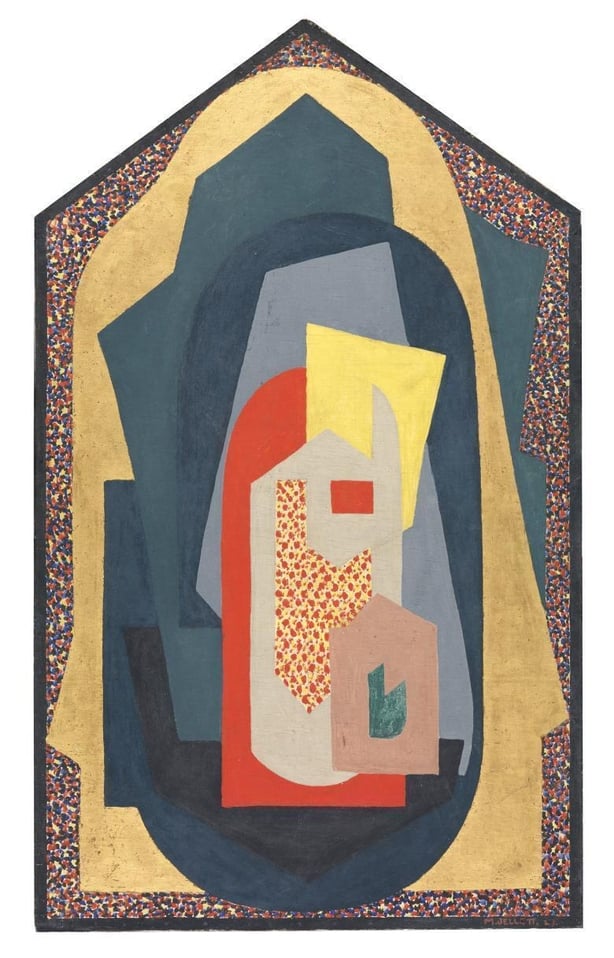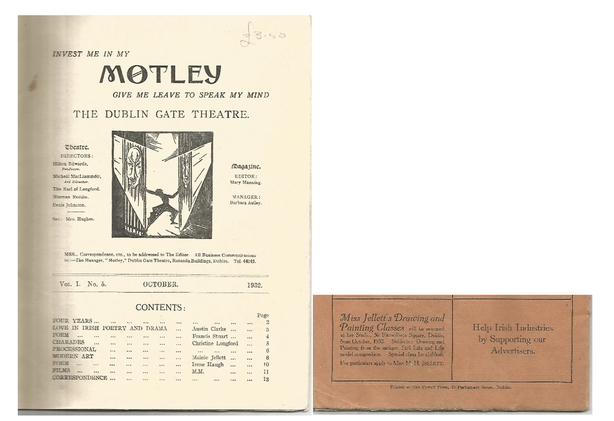Analysis: the 'doyenne of Irish modernism' was pivotal in promoting abstract and cubist art and bringing Irish artists back in contact with Europe
By Billy Shortall, TCD
Art historians and commentators concur that Mary Harriet (Mainie) Jellett (1897–1944) and Evie Hone (1894–1955) were Ireland's pioneering modern artists. In his foreword to Dorothy Walker's Modern Art in Ireland (1997), Seamus Heaney talks of the source of Irish modern art. He acknowledges the importance of Jack Yeats (1871-1957), but, 'in the shaggy outback of male-dominated, cultural-nationalist landscapes, where the academicians [traditional artists] were even more conservative than the clergy … the headwaters of modern Irish abstract art began to gleam and discover a channel for themselves, the naiads of the source being Mainie Jellett and Evie Hone’.
In the decades after Irish Independence, Jellett was almost evangelical in promoting modern abstract and cubist art in a resistant Ireland, although it was well established in Europe at this time. She extensively published, lectured, exhibited and spoke on national radio, in her attempts to engage a sceptical public with modern art.
From National Museums NI, Mainie Jellett's early years as an artist
With no obvious Irish role model early in her own career, Jellett would eventually look abroad, but she had early Irish influences. As a child Jellett displayed talents in both music and art, either could have been a career choice. Her first art lessons were with Elizabeth Corbet Yeats (1868-1940), who gave art classes all her life. Yeats ran the Cuala Press and before that the Dun Emer Industries with her sister Lily and suffragist Evelyn Gleeson. Both enterprises exclusively employed women and were important Irish Arts and Crafts Movement studios with a radical social programme, supporting the emancipation of women through training, education, and employment.
Other art lessons were taken from artist Sarah Cecilia Harrison (1863-1941), who was a staunch supporter of Hugh Lane in establishing a modern art gallery in Dublin and was the first woman to serve on Dublin City Council. Jellett also attended May Manning's (1853-1930) art classes on Merrion Row, and it was here she was advised to travel to France on a sketching trip and enter the Dublin Metropolitan School of Art on her return in 1914.
While at the DMSA, she decided to become a professional artist and went on to train at the Westminster School of Art (1917-19) with Walter Sickert, who she regarded as being ‘in the direct line of French Impressionist painting’. Jellett regarded this period as the ‘first revolution’ in her art, when drawing and composition came alive for her.

It was at the Westminster School that she met Evie Hone who became her life-long friend. In Westminster they were both encouraged to travel to Paris to further their artistic studies. Paris in the 1920s was a world artistic hub, being home to Picasso, Braque and Brancusi, among others. In February 1921, Jellett joined Hone in Paris and they studied with Andre Lhote (1885-1962) for 10 months – her ‘next revolution’. Here, both painters received their introduction into basic cubist theory and Jellett’s sketchbooks from this time show a cubist approach to both figures and landscape.
In December 1921, both Hone and Jellett left Lhote and began working with Albert Gleizes (1881-1953) also in Paris. He was well known as one of the pioneers of Cubism and had co-published a book on Cubism, Du Cubisme in 1912, and continued to develop his theories in later publications. Gleizes' basic approaches were multiple perspectives, translation and rotation, abstract Cubism and non- representational art. Gleizes aided Jellett and Hone’s exploration of new artistic ideas and Jellett called this period her third and ‘final revolution’. She returned to France for a few months each year until 1931 to work with Gleizes.
After finishing her formal contacts with Gleizes, Jellett continued to travel abroad and exhibited in many avant-garde shows. Art was a competitive Olympic competition until 1948 and Jellett represented Ireland at the 1928 Amsterdam Olympic Games. From 1930, she also showed regularly with the London Group in London and at numerous avant-garde shows in Paris.
From National Museums NI, Mainie Jellett's third artistic revolution was when she fully embraced the technique of translation and rotation
Jellett showed her work with Abstraction-Création, an association of international painters and sculptors that promoted the principles of pure abstraction in art. This group included Mondrian, Leger, Kandinsky, Gabo, Gleizes and many other leading contemporary European artists. She regularly showed at the Salon des Surindépendants and took part in L'Art d’Aujourd’hui in 1925, which included Delaunays, Leger, Gleizes, Picasso and others. In all of these shows, she exhibited late cubist and abstract paintings.
Jellett is regarded to have exhibited the first abstract painting, Decoration (1923), by an Irish artist in this country in October 1923. It's now in the National Gallery of Ireland, but it caused a furore at the time. Its five-sided shape was more usually associated with an icon. The Irish Times reviewer ‘could not understand the work’ and more harshly George Russell referred to the work as ‘sub-human’ in his Irish Statesman newspaper review. Some five years later, though, Russell was more positively disposed towards Jellett’s art.
Decoration clearly showed the external influences of Jellett’s training and involvement in European art. Hone also exhibited abstract works but, being more low-key than Jellett, did not receive the same level of attention. Hone would later concentrate on stained glass, joining An Túr Gloine stained glass studio in 1933, and this was to be her métier.

Jellett’s work was selected by the State for exhibition abroad when the aim was to present a modern image of a young progressive state on the international stage. As well as the 1928 Olympics, she was commissioned to design a series of very large murals for the Irish Pavilion at the British Empire Exhibition in Glasgow in 1938, and her art was part of the Irish exhibit at the 1939 New York World's Fair. Jellett had successfully pushed her European influenced modernist agenda to the State.
Her support for modern art was most influential in the late 1930s and 1940s when she herself met with greater critical success. She championed the White Stag Group, a small group of avant-garde artists who as pacifists took refuge in Ireland during the Second World War, and who would not have been welcomed in the conservative Royal Hibernia Academy, the principal exhibition space in Ireland.
Jellett’s involvement with the group had raised their profile, integrated them into the Irish art scene and further expanded the profile of modern art in the country. The group were not alone in being unwanted by the RHA; Louis le Brocquy had two works refused in 1942, and Nano Reid and other young modern avant-garde artists had more work refused the following year.

As the ‘doyenne of Irish modernism’, she was central in the committee established to set up another open submission exhibiting academy, resulting in the founding of the Irish Exhibition of Living Art in 1943 with Jellett as president. Though not excluding traditional art, the exhibition afforded modern and contemporary artists the opportunity to exhibit in a large public salon type show for the first time and it became a leading artistic event in the country. It was active until the 1980s, but was most influential during its first three decades often including international art works and lectures on contemporary art as part of its annual exhibition.
Jellett is credited with bringing Irish artists back into contact with European thought and art and she started the institutionalisation of modern art in Ireland. In 1947, the IELA awarded a Mainie Jellett travel scholarship in her honour. It was won by the young Irish sculptor, Hilary Heron (1923-77), who used the £250 prize to travel to Paris and Europe in 1948 precipitating her becoming Ireland pioneering modernist sculptor. Heron’s retrospective exhibition will open in the Irish Museum of Modern Art later this year.
Follow the RTÉ Brainstorm WhatsApp channel for more stories and updates
Dr Billy Shortall is the Ryan Gallagher Kennedy Postdoctoral Fellow on the Cuala Press Print Project at Trinity College Dublin.
The views expressed here are those of the author and do not represent or reflect the views of RTÉ

